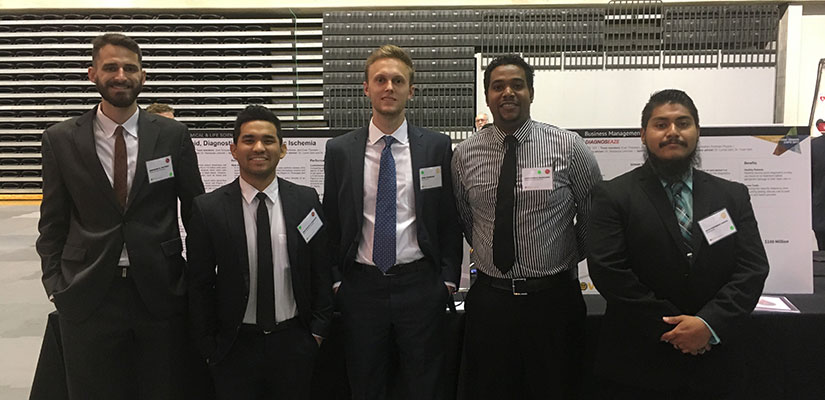Photo: The Diagnoseaze team at the 2017 School of Engineering Capstone Expo: Emerson Physioc, Jose-Carlos Gonzales, Evan Thoresen, Abdelmagid Nasreldeen, Julio Contreras. The team’s faculty adviser is Nastassja Lewinski, Ph.D., assistant professor in the Department of Chemical and Life Science Engineering (not shown).
Alan Rodriguez Espinoza
Originally published in Venture Creation University News
--
Business major Evan Thoresen has been exposed to cardiac health issues for a long time. For seven years, his mother worked as CEO for WomenHeart, a nonprofit based in D.C. that raises awareness about women’s heart disease and provides women with the best care available.
While his mother’s work inspired Thoresen to learn more about cardiac health, it was his aunt’s experience with heart disease that urged Thoresen to take action. When she was hospitalized after experiencing heart problems, she had to wait over four hours to get her results back. By the time her doctors had a reading, his aunt had already experienced necrosis — or death — of cardiac cell tissue and suffered a heart attack.
When cardiac patients enter the ischemic phase, characterized by restriction of blood supply to tissues, they typically have 90 minutes before permanent damage to the heart is done. “Half of patients don’t receive the treatment they need within this time period,” Thorsen said. Thoresen has helped found a business, Diagnoseaze, that aims to address this.
Diagnoseaze began in fall 2016 as a collaborative project between entrepreneurship and engineering students. The startup proposes to enhance health diagnostics with accurate, easy-to-use rapid devices that test for biomarkers associated with myocardial ischemia, the restriction of blood flow that leads to heart attack.
“We’re able to test way ahead, before the necrosis of the heart tissue is actually happening,” Thoresen said. “This allows ER staff and physicians to test patients very quickly and move them to treatment before they reach the heart attack stage.”
Diagnoseaze devices can be brought to patients and used in the field. “This is a lot more convenient than having to draw blood and send it back to the lab,” Thorsen said. Diagnoseaze is making point-of-care devices user-friendly by simplifying myocardial ischemia readings down to a “yes” or “no.”
“A lot of the devices that are currently on the market give you very intricate readings that you have to have extensive medical background knowledge to understand,” Thorsen said.
The startup has identified three segments of users with varied levels of medical expertise, from physicians and emergency room personnel to the patients themselves. Currently, medical professionals are the company’s primary target. In the future, they hope to make the devices accessible enough for patient use, similar to glucose monitors.
Engineering students Jose-Carlos Gonzales, Emerson Physioc and Abdelmagid Nasreldeen handled design and functionality, while Thoresen and his entrepreneurship colleague Julio Contreras conducted market research and learned about how to approach investors. Natassja Lewinski, Ph.D., assistant professor in VCU’s Department of Chemical and Life Science Engineering, is the group’s faculty adviser.
Diagnoseaze, the school project, reached its culmination when the team graduated. Diagnoseaze, the company, continues to grow. The company is developing a functional prototype of the machine, which will be followed by a two or three years of clinical trials. Thoresen thinks this process will be very capital intensive. He is not discouraged, because he believes the team’s innovation offers a significant solution to cardiac health.
“We’ve just gotten so much positive feedback from other people that it kind of weighs that out,” Thoresen says. “It makes it seem like a much more achievable goal, something that you really want to work towards because it can have such a great impact.”
